
Adrian Killins (in blue, image via Ormond Beach Observer)
For Michigan fans, maybe the most disheartening play of the 51-14 win over Central Florida was freshman running back Adrian Killins breaking off an 87-yard touchdown run against a defense that’s deemed one of the best in the country. Here’s how it happened:
Above: Central Florida is in 12 personnel (1 RB, 2 TE) with a tight end left and an H-back in a wing position; on the other side, UCF has an inverted slot. The RB is to the strong side of the formation. Michigan is in a Cover 3 shell with safety Dymonte Thomas shading the twins side. Up front Michigan is in an Over G look with SAM linebacker Jabrill Peppers in a loose 9-technique (outside the tight end), MIKE linebacker Ben Gedeon aligned in the strong C-gap, and WILL linebacker Mike McCray splitting the difference between the weakside tackle and the slot receiver. It’s noteworthy that strong safety Delano Hill is two yards off the LOS outside the SAM linebacker, so Michigan has 6 defenders to the short side of the field.
Above: The outside wide receiver comes in motion to tighten his split, which is key because now he has a good angle to crack down on McCray. He and the slot receiver will cross block the WILL and the corner to create a seam. Otherwise, the only change pre-snap is Stribling following the receiver in motion for a few yards.
Above: Both offensive guards pull to the left as UCF quarterback Justin Holman reads WDE Marshall. Marshall, whose offensive tackle released inside, turns his shoulders to chase, but the read is coming at him. Holman can either hand the ball to running back Adrian Killins or keep it himself to follow his pulling guards. On the strong side, the H-back is kicking out a blitzing Jabrill Peppers at the 10-yard line and the TE is blocking down on SDE Chris Wormley. Holman isn’t reading the strong side, but it’s a good thing for him that he doesn’t keep it because there’s one pulling guard with two defenders standing in the hole. At the top of the screen, McCray is stepping up as the crease player to stop Killins while Stribling maintains contain to the sideline. The one guy not in the screenshot is free safety Dymonte Thomas.
Above: With the defensive line in hot pursuit, McCray has tried to fight back outside of the WR’s crack block, while Stribling tries to squeeze down from his force position at corner. The WR has his hands extended but inside McCray’s frame, so it’s a difficult call to make as an official. You can see that defensive tackle Graham Glasgow (#96) has chosen to try to take an angle rather than coming straight down the line, since he knows he won’t catch Killins from behind.
Above: Now McCray is trying to turn away from the block, which should necessitate a holding call if the officials can catch it. Stribling is maintaining his force position. Thomas still isn’t in the field of vision, and backside CB Jeremy Clark has just now turned to run.
Above: The WR blocking Stribling has his hand extended now, and FS Dymonte Thomas now appears at 12 yards off the LOS after starting off 14 yards from the ball. Killins started off 5 yards behind the LOS, ran laterally, and is now 5 yards beyond the LOS, all while Thomas ran laterally and forward 2 yards. That speaks to the play call holding Thomas in the middle of the field, but it also shows just how quickly Killins gets to the edge. Thomas, meanwhile, is throttling down, despite losing more and more leverage with every step.
Above: As Killins crosses the 30-yard line, Thomas has lost leverage and flails helplessly as Killins speeds past him. Defensive tackle Glasgow is the next closest Wolverine, but despite the admirable hustle, he’s not going to catch a guy who runs a 10.3 in the 100 meters.
Above: Normally, this shot would be superfluous, as we all know that nobody caught Killins on his way to the score. The reason I took this screenshot is that backside CB Jeremy Clark comes onto the screen behind Killins at the 25-yard line. Few people, if anyone, on Michigan’s team are going to catch Killins.
You can see the full play HERE or at 46:07 of the video below:
TAKEAWAYS
- This is a clever play for spread teams to run. Unlike inside zone, the blocking scheme gets guys out in front for the QB if he keeps it. Meanwhile, the backside end has to make a choice about whether to chase or to stay wide, but it’s made more difficult because the player coming toward him (the RB) is coming at full speed, whereas a QB is often slower and coming from a virtual standstill. In other words, this read has to come a lot faster than the standard zone read option.
- Schematically, Michigan was fine here. They had a DE to handle the mesh, an OLB to take the crease, a FS to fill the alley, and a CB to keep contain. The execution was poor, though. McCray and Stribling didn’t get off their blocks, and Thomas took a poor angle. Defensive coordinator Don Brown has a few different ways of handling the mesh, so it’s unclear whether Marshall did his job or not. And on the strong side of the play, it would have been shut down for little to no gain.
- Speed kills. Thomas is one of the fastest guys on Michigan’s team, but he couldn’t fill the alley fast enough. Killins didn’t make him miss or do anything fancy. He just ran as fast as he could for the sideline, and Thomas couldn’t get there. Killins has the 5th most carries of UCF’s running backs, so when you can run your 5th-stringer out there to do things like run 87 yards for a touchdown, then you’re onto something. That’s Denard Robinson-like speed, and that’s why Michigan should always try to have one or two guys on the team who can make big plays like that, even they’re not clear-cut starters at any particular position.
- Holding helped, but I don’t think it made the play. I think UCF got away with a couple holds here, one on McCray and one on Stribling. Even if those receivers don’t hold there, though, I’m not sure whether McCray or Stribling actually would get a hand on Killins. It was well executed by UCF, and without Thomas filling the alley to slow down Killins, it’s a moot point. Neither one is going to be able to chase him down.
- This is a poor angle by Jeremy Clark. I threw that last screenshot in there to show how poor the angle was by Clark. Whether by a split-second poor decision or because Michigan didn’t have a scouting report on the freshman running back, Clark didn’t account for Killins’s speed. The aiming point for the backside corner should be the front pylon of the endzone, but you can see Clark running almost directly behind Killins as he reaches the 25. I don’t know that Clark catches him with a good angle or not, but this one sure didn’t work.
You need to login in order to vote

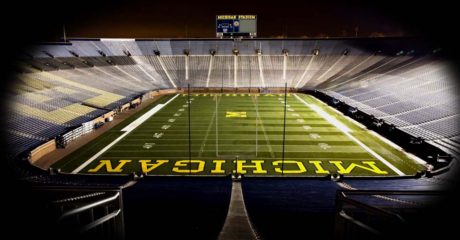
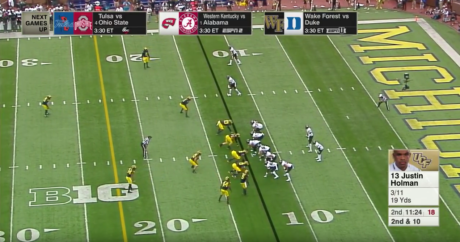
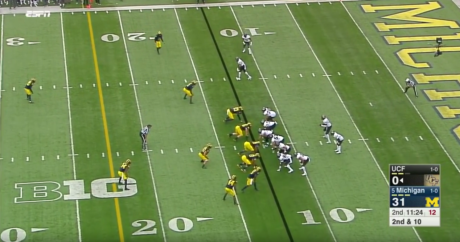
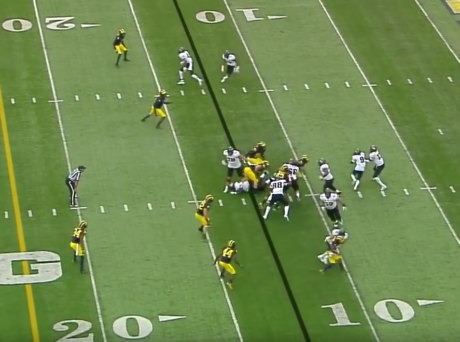
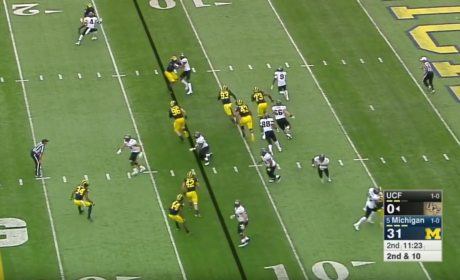
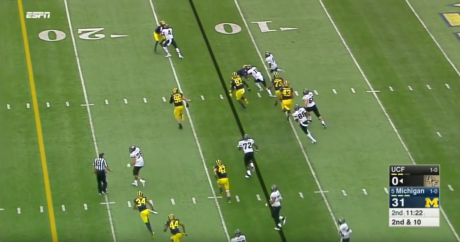
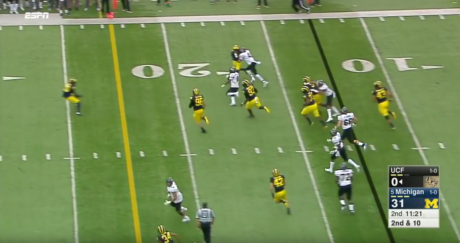
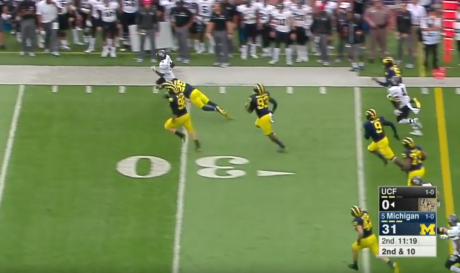
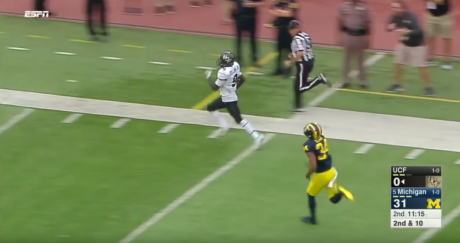
Nicely done.
You need to login in order to vote
Outstanding work Thunder — I’ve been telling my son to hold, but with the hands inside for a looong time!
You need to login in order to vote
Fantastic write-up!
You need to login in order to vote
Thanks!
You need to login in order to vote
Sure looks to me like McCray would have been in excellent position to make a if he hadn’t been held. On the replay, you can see him try to pull away multiple times, starting well before Killins gets to the hole. So I guess what I’m saying is, I think holding did indeed make the play. Thomas’ mistake would have never been an issue if McCray had been allowed to get to his spot and bring him down after a gain of 2 or 3.
You need to login in order to vote
It’s possible that holding made the play. It’s hard to say for sure.
You need to login in order to vote
Fair enough. Brian’s game recap seems to agree with you on this one, so it looks like I’m outnumbered.
You need to login in order to vote
So Thomas probably should’ve made the tackle, but should he have somehow tried to force him back inside? If Thomas darts for the hashmarks, and then makes Killins juke inside of him, isn’t there a better chance of someone catching him? I guess the question is, what do you coach the player to do 17 yards down field?
You need to login in order to vote
The force player’s job (so Stribling’s job) is to force him back inside. The alley player is supposed to stay on the back hip of the runner. If he aims too far outside and the runner cuts back behind the alley player, then that’s bad news for the defense. It should almost be like a vise, with Stribling and Thomas meeting at the ball carrier. Unfortunately, Stribling isn’t physical enough here and doesn’t get off the block.
You need to login in order to vote
Interesting!
You need to login in order to vote